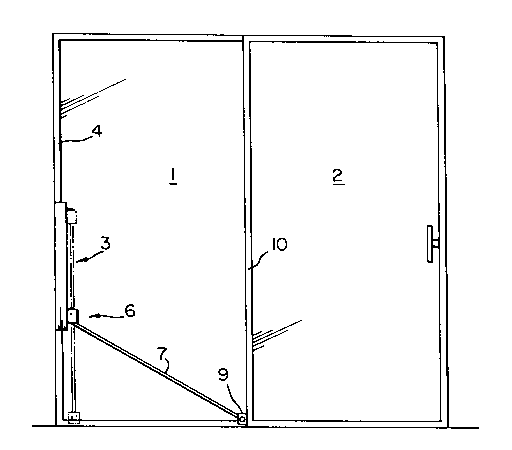Some of the information on this Web page has been provided by external sources. The Government of Canada is not responsible for the accuracy, reliability or currency of the information supplied by external sources. Users wishing to rely upon this information should consult directly with the source of the information. Content provided by external sources is not subject to official languages, privacy and accessibility requirements.
Any discrepancies in the text and image of the Claims and Abstract are due to differing posting times. Text of the Claims and Abstract are posted:
| (12) Patent: | (11) CA 2042475 |
|---|---|
| (54) English Title: | DOOR AND WINDOW LATCH |
| (54) French Title: | DISPOSITIF DE VERROUILLAGE POUR PORTE ET FENETRE |
| Status: | Term Expired - Post Grant Beyond Limit |
| (51) International Patent Classification (IPC): |
|
|---|---|
| (72) Inventors : |
|
| (73) Owners : |
|
| (71) Applicants : |
|
| (74) Agent: | |
| (74) Associate agent: | |
| (45) Issued: | 1996-07-16 |
| (22) Filed Date: | 1991-05-13 |
| (41) Open to Public Inspection: | 1992-11-14 |
| Examination requested: | 1992-10-14 |
| Availability of licence: | N/A |
| Dedicated to the Public: | N/A |
| (25) Language of filing: | English |
| Patent Cooperation Treaty (PCT): | No |
|---|
| (30) Application Priority Data: | None |
|---|
In general, latch devices for sliding patio doors
are complicated and/or intended to lock a door fully closed.
A simple device for latching a sliding door or window partly
or fully open or fully closed includes a track for mounting on
a frame opposite the side edge of a movable door or window
panel; a slide for slidable mounting on the track; a bracket
for mounting on the edge of the panel at the bottom thereof; a
rod pivotally connected to the slide and to the bracket; a
bolt slidable in a recess in the slide body which contains a
spring for biasing the bolt outwardly against teeth on the
track, the teeth normally permitting movement of the slide in
one direction on the track so that the door can be closed but
not opened; and a pin for insertion through the slide into the
bolt to hold the bolt retracted in the slide, so that the door
can move freely between the open and closed positions.
Note: Claims are shown in the official language in which they were submitted.
Note: Descriptions are shown in the official language in which they were submitted.

2024-08-01:As part of the Next Generation Patents (NGP) transition, the Canadian Patents Database (CPD) now contains a more detailed Event History, which replicates the Event Log of our new back-office solution.
Please note that "Inactive:" events refers to events no longer in use in our new back-office solution.
For a clearer understanding of the status of the application/patent presented on this page, the site Disclaimer , as well as the definitions for Patent , Event History , Maintenance Fee and Payment History should be consulted.
| Description | Date |
|---|---|
| Revocation of Agent Requirements Determined Compliant | 2020-09-01 |
| Inactive: Expired (new Act pat) | 2011-05-13 |
| Inactive: IPC from MCD | 2006-03-11 |
| Grant by Issuance | 1996-07-16 |
| Application Published (Open to Public Inspection) | 1992-11-14 |
| Request for Examination Requirements Determined Compliant | 1992-10-14 |
| All Requirements for Examination Determined Compliant | 1992-10-14 |
| Small Entity Declaration Determined Compliant | 1991-05-13 |
There is no abandonment history.
| Fee Type | Anniversary Year | Due Date | Paid Date |
|---|---|---|---|
| MF (patent, 7th anniv.) - small | 1998-05-13 | 1998-05-12 | |
| MF (patent, 8th anniv.) - small | 1999-05-13 | 1999-04-23 | |
| MF (patent, 9th anniv.) - small | 2000-05-15 | 2000-05-11 | |
| MF (patent, 10th anniv.) - small | 2001-05-14 | 2001-05-09 | |
| MF (patent, 11th anniv.) - small | 2002-05-13 | 2002-05-09 | |
| MF (patent, 12th anniv.) - small | 2003-05-13 | 2003-05-09 | |
| MF (patent, 13th anniv.) - small | 2004-05-13 | 2004-04-20 | |
| MF (patent, 14th anniv.) - small | 2005-05-13 | 2005-05-03 | |
| MF (patent, 15th anniv.) - small | 2006-05-15 | 2006-05-03 | |
| MF (patent, 16th anniv.) - small | 2007-05-14 | 2007-04-24 | |
| MF (patent, 17th anniv.) - small | 2008-05-13 | 2008-05-05 | |
| MF (patent, 18th anniv.) - small | 2009-05-13 | 2009-05-12 | |
| MF (patent, 19th anniv.) - small | 2010-05-13 | 2010-03-11 |
Note: Records showing the ownership history in alphabetical order.
| Current Owners on Record |
|---|
| PIERRE VEILLETTE |
| Past Owners on Record |
|---|
| None |